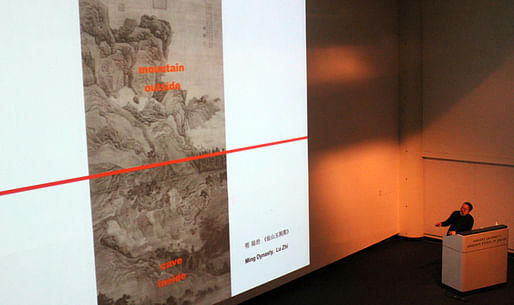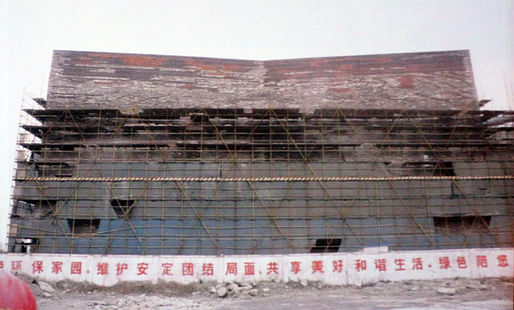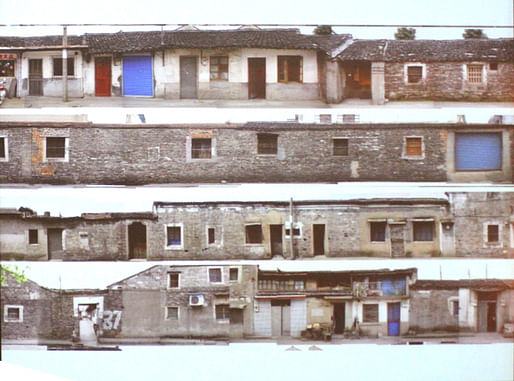
Hi Archinect!
It's Open House day at the GSD, so we're in "full Piper" (using the entire auditorium) for a lecture by Wang Shu from Amateur Architecture Studio. The video is now viewable at the GSD website and the GSD's YouTube channel.
4:05 pm: A long and laudatory introduction from Scott. He's talking about how, whereas many architects have struggled with the imprecise and fast-track methods of architectural design and construction in China, failing to build works with a precision in how intentions are realized, Wang Shu has found ways around this. He is one of the most experimental and outspoken architects in China.

4:10pm: Wang Shu starts. China is an abstract idea and a recent one; he thinks of himself as influenced more by his town of Hangzhou and by Zhejiang province than by "China" as a whole.
Hangzhou has village and city conditions coexisting.

The landscape is almost like a religion for people who often don't have a single specific religion. And yet, the rush for development is so strong that people think nothing of brutally cutting a mountain to construct an (ugly, unartful) highway. He's lamenting that 90-95% of traditional buildings in China are being demolished and replaced by new developments.
But Hangzhou is "still better than Shanghai" because it has kept its old (pre-1950s) city more. "For me Shanghai, is not China; Hangzhou is China."
Now here's a big slide with the following questions:
How do we face china's "unusual situation of great explosion of new architecture"?
How do we face the "delirious wave of development"?
And another:
In this country whom most strongly embracing globalization on this globe, how do we emphasize the respect for and blending into the Chinese traditional culture?
And can we melt down the conflicts of the so called nationalization and localization?
He's criticizing the will in China to become more American, to demolish much of its history to develop. "For me, I can't do this...I think the professional urban planner and architect create this disaster together. That is why we call ourselves Amateur Architects. To do things different, some serious thinking. Chinese culture is not an abstract concept; it comes from the land, the local tradition."
Nature is more important than people, and we should let nature be our teacher. He's talking about the Chinese tradition of landscape painting and how this is a traditional way think through nature. Lots of slides of traditional landscape paintings; and now an animation taking us through a scroll.
"We don't have a middle class in China. We have a scholar class. People might farm, but after they finish their fields, they go back and read a book or make a painting."
What is the meaning of this painting? It is similar to design. Traditionally, architects in China only did drawings like these painted landscape scrolls, and built gardens (like those in Suzhou) from these paintings. They did not produce [plans and sections].

He's now reading landscape paintings and showing how they are structured: narratives of inside and outside, mountain and water. These paintings are "not just about drawing natural things, but it is about understanding. It is a re-composition of nature."

5:05pm: Hm, one hour in and no pictures of AA's architecture projects yet. Bold!
"I asked the students: do you think traditional Chinese architecture has a façade? No, it does not. The elevation is not important; it's the (deployment of the plan) and the inner experience."
Now he's talking about the scalar shifts that happen in these paintings: human figures can appear in the painting at the same size, but representing vastly different scales. He's showing us two details of a painting; in one, the people are bigger than whole towns that are drawn next to them, and in the other, the people are drawn in a context with a more expected scale. And when you zoom in to different parts of the painting, there are details and whole little scenes and worlds depicted. The painting cannot be taken in at once; you have to move through it. It's very different than most painting traditions in the west, where you're able to get a sense of the overall painting from a view of the whole or overall forms. I daresay that my studio critics would describe this use of scale as "Piranesian."
In traditional Chinese thought, without fresh air--if no air penetrates the building--it means the building is dead. We're looking at depictions of buildings in paintings from the South Song Dynasty, and seeing how many are drawn as pavilions or as enclosed buildings with openings.
5:16pm: Slide: Architecture as a mountain.

Ooh, his projects! He's showing a small house and talking about the windows and sightlines. "The building is very small. But it controls the whole site through vision."






Now he's talking about the construction process for the museum in Ningbo. They developed design drawings on the computer, and gave these to the craftsmen. One wall in particular is large (24m high) and has many different kinds of bricks in an abstract pattern. When the workmen are working on it, they can't see the whole wall at once, just the part they're working on. He's saying that he has control and does not have control of the exact process and that he enjoys this play. "It's my design but it's different from my design."

None of his projects have a single logic: he likes to have two logics or more. "Nothing in the world has a single logic."


The museum has been very popular in China. Millions of visitors, and many who return over and over. He talked to a women who said to him: "My house has been demolished. But I can find memory here."
"I don't design a street, a building. Every time I design a new world. Designing a world is quite different from designing a building." Chinese gardens in Suzhou are not just about gardens; they're about ideas for urban design. They are cities.
Wang Shu is still wrapping up but unfortunately I gotta head out. The Museum of Fine Arts is screening Gary Hustwit's Urbanized tonight and for a paltry $18, I will get to watch this film and hear Hustwit address the masses...
Thanks for reading!
Lian
This blog was most active from 2009-2013. Writing about my experiences and life at Harvard GSD started out as a way for me to process my experiences as an M.Arch.I student, and evolved into a record of the intellectual and cultural life of the Cambridge architecture (and to a lesser extent, design/technology) community, through live-blogs. These days, I work as a data storyteller (and blogger at Littldata.com) in San Francisco, and still post here once in a while.



3 Comments
Great! I can't wait to see the video... can you update with a link when it's posted?
I'll do something like this.
OK, done! The links are above in the post.
Block this user
Are you sure you want to block this user and hide all related comments throughout the site?
Archinect
This is your first comment on Archinect. Your comment will be visible once approved.